Hometown heroes
Local soft baits hit national scene
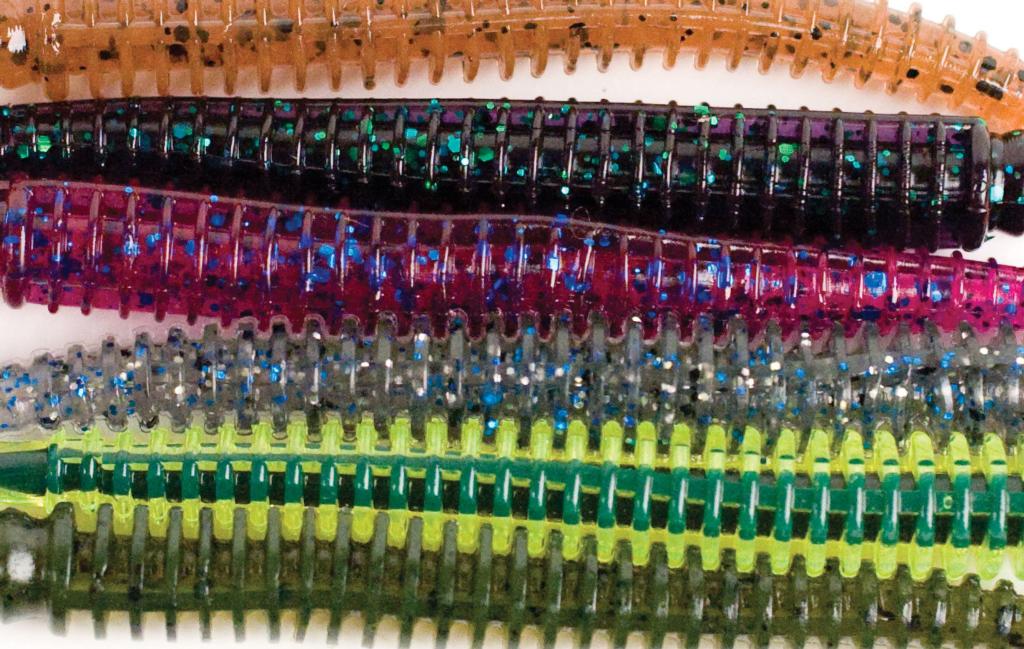
Wishing and politics share some similarities. When it comes to elections, all politics are local and only a few select candidates manage to generate the widespread appeal that might elevate them to the national stage.
Compare that to walleye fishing, which involves a broad network of localized fishing waters and patterns, where certain lures and techniques enjoy regional popularity and success. While individual lures often become “the” way to fish on local waters, only a handful of them ever make the leap from hometown heroes to national prominence, helped along these days by the Internet and the instant access to information that it affords.
A prime example: the evolution of artificial soft baits for walleye fishing – a trend that has grown in the walleye industry during the last decade. Spurred on in large part by local successes, soft-plastic or biodegradable lures that imitate forage are rising in popularity everywhere.
What follows are some examples of regionally popular soft baits and generic soft-bait shapes, along with how to put them to good use wherever you might fish. Some have already developed reputations beyond their home regions, while the popularity of others is still locally contained. One thing is true, however: These are soft baits that can produce for walleye anglers across the country.
Trigger X Minnow
Origin of popularity: Northern Minnesota
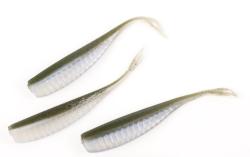
The Trigger X Minnow and other small minnow-shaped, fork-tail soft baits like it are outstanding jigging options, especially for aggressive snap-jigging presentations. Rigged on a jighead with a wire keeper, the Minnow is stuck there nearly for good, unlike a live minnow that might fall off on the cast and is definitely gone after ripping it once or twice from some “sticky” cover.
Al Lindner is a huge fan of the Trigger X Minnow profile, which seductively flicks the tail on every twitch of the rod tip. One of his primary patterns is to forward-troll the shallows on big lakes like Winnibigoshish or Mille Lacs. He lets out 60 to 70 feet of line, sets the trolling motor speed to scour the flats aggressively, and then snaps the rod tip every few seconds to make his 1/4-ounce jig-soft bait combo dart, dance and plummet.
A similar rod-tip action can be used to snap-jig deep structure, or even to twitch and snap within weedbeds. Basically, if you want a traditional jig-and-minnow combo that is more durable than the real thing, look to minnow-shaped soft baits such as the Trigger X Minnow.
Where it could be a hit next: Any time walleyes suspend, but can’t be targeted by trolling, such as in lakes with one-rod regulations or along drop-offs lined with snaggy timber, a Trigger X Minnow rigged on a light jighead is a great enticer to make walleyes bite. Use the depth finder to target individual fish, and rip the jig-soft bait combo up and down above the fish.
Berkley Gulp! Minnow Grub
Origin of popularity: Weedy natural lakes in north-central Minnesota
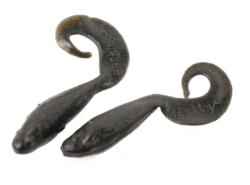
The area from Walker to Grand Rapids, Minn., has many weedy natural lakes where walleyes relate heavily to weed edges in summer. To fish them, innovative walleye guides troll 3-inch Gulp! Minnow Grubs rigged on single-hook spinner rigs.
The best setup involves a relatively modest No. 3 Colorado blade and a large 2/0 Aberdeen hook – either rigged exposed or Texas style. The snell is shortened to about 12 to 18 inches, and a barrel swivel tied into the line. Ahead of the swivel, substitute a 1/4-ounce bullet sinker for a traditional walking slip-sinker.
The resulting sinker-spinner-snell combo slips and slithers through fringe weed growth along deep weedlines, rather than wrapping or fouling on weed stalks as might happen with longer rigs and other sinker styles. It’s great for covering large amounts of water to locate walleyes on big lakes such as Leech and Winnibigoshish, and works wonders on smaller, weedy natural lakes.
Where it could be a hit next: Any reservoir with standing timber offers many of the same challenges for trollers as natural lakes with weedy cover, most notably: snags. A weedless spinner rig with a soft-bait grub, as opposed to live bait, is much more efficient and less frustrating to fish than a traditional live-bait spinner rig with an open hook.
Berkley Gulp! Nightcrawler
Origin of popularity: Great Lakes

Gulp! Nightcrawlers have wormed their way into big-water spinner-trolling presentations across the Great Lakes region. Chiefly, these rigs involve spinner harnesses with No. 5 to 7 blades. Anglers trolling for suspended fish often clip a snap weight to the line a few feet ahead of the spinner harness. Depending on depth, 1 to 2 ounces usually does the trick. Positioning the sinker about 10 to 20 feet ahead of the spinner creates a gentle swimming action. Clipping it within a few feet of the spinner, by comparison, imparts more of an up-down fluttering action.
A second option substitutes a cylindrical trolling sinker tied into the line about 4 feet ahead of the spinner harness. This definitely enhances the rise-flutter action created as the boat surges in waves, or as trolling speed is varied from about 0.5 to 1 mph, then stalled for a few seconds to let the lure sink and flutter.
The same rig is great for trolling near bottom along sandy shoreline drop-offs – although you generally don’t let the sinker touch bottom, risking having the line cut by zebra mussels attached to rocks and weeds.
Where it could be a hit next: The Missouri River, and all its reservoirs, is the home of the Slow Death rig, the premise being that a live crawler (or half a crawler), slid partially up the shank of a hook that is kinked in a partial S-shaped pattern, will create a seductive swirling action when pulled through the water. Substitute a Gulp! Nightcrawler for the real thing, and you have a rig that can stand up to many more bites from the Missouri’s massive populations of smallmouths and walleyes.
Lunker City Fin-S Fish
Origin of popularity: Detroit River
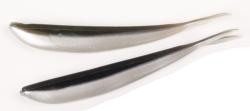
Lunker City is a Connecticut-based tackle company that primarily caters to bass anglers and is best known for its Slug-Go slug-bodied twitch bait. Additionally, the company’s 4-inch Fin-S Fish has emerged as a jigging favorite for several National Guard FLW Walleye Tour pros, especially when deep jigging in the heavy current of the Detroit River.
Much of the advantage of the Fin-S Fish over a live-bait jigging presentation is the ability to target the largest walleyes, which is what it usually takes to eat a large soft plastic on a heavy jig. If you’re after fish of truly trophy proportions, increase to a 5- or 5 3/4-inch Fin-S Fish, just be sure to add a stinger hook.
The Fin-S Fish is also a great casting lure for working shallow vegetation, and it’s a dynamite snap-jigging lure for working deep weed edges. It is tough, yet flexible, with a seductive twitching action of the tail.
Where it could be a hit next: As mentioned, the Fin-S Fish is a great jighead lure for fishing in and around weeds at all depths. Where it could also excel is in the fall on natural rocky lakes, such as Leech, where big baits really do tempt big fish. In clear conditions, or if targeting walleyes under the slot, snap-jigging or rigging live bait is a must. But in windy conditions with decreased clarity, a 4- or 5-inch Fin-S Fish snap-jigged on windblown structure could be a hit.
Wyandotte Worm
Origin of popularity: Detroit River
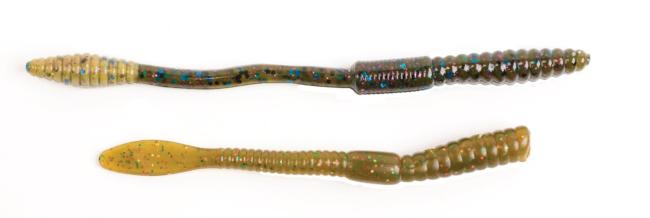
The Wyandotte Worm is another popular local lure from the Detroit River. It, too, has been on the jighead of many a National Guard FLW Walleye Tour pro, and for good reason.
Its thin, flexible body bends and surges when the worm – rigged on a jighead – bounces off the bottom. The flat, broad end of its tail grabs water and flicks about as it rolls in current. It’s not wild and crazy, but it’s got a surprisingly effective combination of a finesse body and wiggly action that makes it killer in rivers, especially if fish are feeding on worms or lampreys.
Until recently, the Wyandotte Worm was so local-centric that it was only available at tackle shops in the Detroit River vicinity. However, Big Bite Baits released a new worm known as the Squirrel Tail Worm, which, although marketed for bass anglers, has the same wiggling action as the original Wyandotte Worm, with the addition of scent and taste walleyes love. The tail also floats, so it will stay up out of bottom sediment in a river.
The worm is best fished on a simple jighead, with the weight matched to the depth and current being fished. You might want to add a stinger hook, since the tail is so far from the jig-hook.
Where it could be a hit next: It’s more than just a bottom lure for bouncing along in a river. Try rigging it weedless and pitching it to wood cover or weeds. Or snap-jig it.
Four-inch ringworms
Origin of popularity: Upper Mississippi River
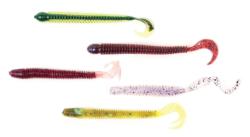
Long considered subtle bass lures, small, soft, flexible ringworms are producing walleyes like crazy on the upper Mississippi River in Minnesota, Wisconsin and Iowa. Anglers typically rig ringworms on lightweight jigheads, such as 3/32 ounce, and swim them through flooded cover in spring; vertically jig them in fall; or anchor, cast and let them tumble downcurrent across the basin in winter. The flexible ribbed body creates extreme action, even in cold water. Trapped air bubbles escaping from between the ribs add to the appeal.
Included in this category are: 3 3/4-inch Lindy Munchies Thumpin’ Ringworm, 4-inch Northland Slurpies Ringworm, 4-inch Hutch Fishing Tackle Ring Worm, 4-inch Barlow’s Tackle Ribworms, 4-inch YUM Rib Worms and 4-inch Gene Larew Salty Ring Tails. All will catch walleyes.
Where it could be a hit next: The keys to the ringworm’s effectiveness are its limber body and air-trapping ribs, both of which allow it to wobble, roll and practically slither along bottom. Its possibilities are endless. Jig it in the spring on Erie’s reefs, where current from wind or tributaries exists. Stuff a rattle in it and cast it to rocky shorelines at night, jigging it so it “rolls” down the slope. Or pitch it into weeds on the lightest jighead you can stand, snapping it free of snags and letting it flutter back.
Northland Mimic Minnow Shad and Shiner
Origin of popularity: Northern Minnesota
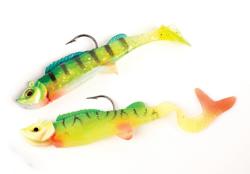
Northland Mimic Minnows are heavily in play in the Bemidji area of northern Minnesota, where Northland Fishing Tackle is headquartered, and are expanding in all directions.
They excel for deep vertical jigging, swimming over weeds, fluttering and ripping deep weedlines, and a host of other aggressive tactics that require a durable soft plastic.
Mimic Minnows come in Shad (paddle-tail) and Shiner (curly tail) models. They are available in bulk, or pre-rigged on minnow-shaped jigheads along with extra component bodies.
They can be fished much the same way as crankbaits, with the advantage of being much more weedless. There are even trolling possibilities, especially in places where subtle minnow spinner rigs are effective.
Where it could be a hit next: The Shiner model is basically a more realistic version of the traditional jig-and-grub combo, which is a deadly vertical tool on rivers across the country – and that is exactly where it should be adopted next.
Boot-tail Shads
Origin of popularity: The prairie states
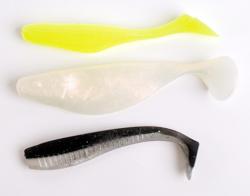
Three- to 4-inch soft-plastic boot-tail shad bodies have been around nearly as long as curly-tailed grubs. Examples include the Trigger X Paddle Tail Minnow, Mister Twister Sassy Shad and Sassy Grub, and Lunker City Grub.
These can and do catch plenty of walleyes, especially when swimming retrieves are called for. For example, in the fertile farm-country lakes of northern Iowa and the glacial lakes region of northeastern South Dakota, dark water, soft basins and rocky shorelines add up to loads of shallow walleyes feeding along shorelines at night. Anglers fish mid-lake areas by boat during the day, but come out in droves at sunset to line the banks near causeways, creek inlets, rocky points and bay mouths. The relatively snag-free body of a boot-tail shad rigged on a 1/4-ounce jig is ideal for swimming through the shallows (typically 2 to 4 feet deep).
Walleyes prefer a slow, steady swim and throbbing vibration, which helps them locate lures in the darkness. Some boot-tail shad bodies are a bit too thick and stiff in the tail, which tends to stifle the throbbing tail action. If so, trim and thin the bottom of the tail section, where it meets the body.
Where it could be a hit next: trolling. As swimbaits (brethren to boot-tail shads) become increasingly popular in all fishing realms, more and more walleye anglers will start picking them up, even if it’s because they accidentally catch a few walleyes on a weekend bass outing. And as more walleye anglers pick them up, more will begin to look for ways to incorporate them into their trolling arsenals, as well.
Color coordination
With every color in the rainbow now available in single, dual and triple combos, choosing the right color 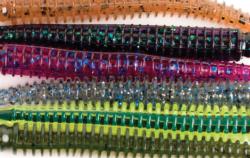 for soft bait might be challenging. Just remember that the basics still apply. Subtle silver and white bodies excel for clear water, and where walleyes feed on shad, ciscoes, shiners and similar silvery baitfish; bright color combos of orange, chartreuse and yellow provide high-visibility options that walleyes can see well in dim- or dirty-water environments, and mimic colorful baitfish like yellow perch. Otherwise, anything goes.
for soft bait might be challenging. Just remember that the basics still apply. Subtle silver and white bodies excel for clear water, and where walleyes feed on shad, ciscoes, shiners and similar silvery baitfish; bright color combos of orange, chartreuse and yellow provide high-visibility options that walleyes can see well in dim- or dirty-water environments, and mimic colorful baitfish like yellow perch. Otherwise, anything goes.
On the upper Mississippi, for example, veteran river rats such as Chevy pro Jason Przekurat of Stevens Point, Wis., and Nick Johnson of Elmwood, Wis., often go with 4-inch black-and-purple ringworms, which is a color combo that few anglers would try for walleyes in stained river environments. Apparently, the dark profile is visible, even if the color itself isn’t.
Local-hero hard lures
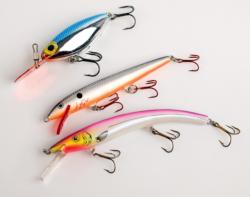 Just to show you that the local-favorite phenomenon isn’t limited to soft baits, here are three examples of hard crankbaits that dominate different localized walleye fisheries.
Just to show you that the local-favorite phenomenon isn’t limited to soft baits, here are three examples of hard crankbaits that dominate different localized walleye fisheries.
Storm Original Hot’N Tot – By far, this is the dominant trolling lure on Saginaw Bay in Michigan for big migratory walleyes from Lake Huron and beyond. Its flash, wobble and vibration fascinate both fishermen and fish, especially the models with red lips.
Rapala Original Floater – The original balsa minnow lure remains the undisputed long, thin minnow-imitator for long-line trolling the shallows at night throughout the North, from Mille Lacs Lake to Lake Geneva. If anything, local color preferences apply.
Reef Runners – Locally headquarted in northern Ohio and regionally dominant on Lake Erie’s Western and Central basins, these humpbacked minnow-imitators are deadly for giant ‘eyes, spring, summer and fall, thanks to their vibrant actions and pulsations.